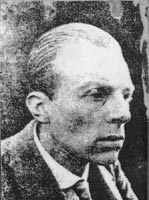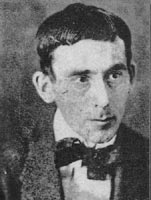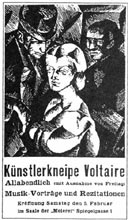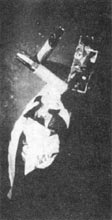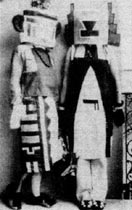by John Scanlan
|
|||||||||||||||||||||||||
| “If you are alive, you are a Dadaist,” Richard Huelsenbeck wrote in 1920. Huelsenbeck belonged to the now well-known group of poets and performers who came together in Zurich during 1916 under the name Dada. Whilst Dadaist movements appeared in other places, and took on different manifestations, the Zurich Dadaists were concerned principally with poetry and performance. And if Dada may be defined or understood in many ways, it is arguable that to those in Zurich in 1916 Dada was precisely about the ambiguity of language and its relation to the world, and this was not only demonstrated through performances and writing, but also in the attempt to resist the kind of identification that language, seemingly, cannot escape:
As the mediator of sense experience and as a regulator of ideas and concepts, the use of language--one may even say, of words--was extremely important to Huelsenbeck, Hugo Ball and the others (Figs. 1 and 2). And we may suggest that where Richard Huelsenbeck could claim that being itself was ambiguous (i.e., being, like Dada, was ‘elastic’), he was aware that language both connects and disconnects the individual from a world of experience; and we may read what the Zurich Dadaists proclaimed as suggesting that life was a kind of Heraclitean flux, in which all objects, experiences and perceptions were fundamentally unstable. Life, in short is ever moving forward, whilst language (which, in its attachment to categories of understanding, always works in a backward direction), by contrast, masks a kind of immanent disorder. The problem with language was not only one of, say, referentiality, but also of the way in which it gives order, or ‘makes’ the world--and in this sense the uses of language can be nefarious: “Human beings,” Huelsenbeck added, “are simply ideologues if they fall for the swindle perpetrated by their own intellects; that an idea, symbol of a momentarily perceived fact, has any absolute reality” (Huelsenbeck, 1993: 9-11). 1. Logos and Identity
In this essay I want to suggest that the play of identity in language and appearance that was a feature of the short-lived Cabaret Voltaire (Fig. 3), which the Dadaists established in Zurich in 1916, can be read as an attempt to destroy the idea of logos, by which I mean it was an attack on the idea that reason (through the mediating discourse of identity) reveals its own perfectibility in overcoming the shortcomings of the historical present, by reaching towards a future that would be evermore perfect. So whilst the word ‘logos’ translates as ‘word’ or ‘speech’ its associations are far richer than this, and in general terms logos refers principally to a series of developments within the philosophical tradition of the West, which taken together can be understood as an idea of perfectibility, or of the power of reason to attain such perfection. As Mark C. Taylor has written:
Thus, any attempt to understand (under-stand as Taylor says), justify, or examine a ‘reality’ beyond appearance, or the relationship between language and such objectivity becomes part of this logocentric tradition, even, it is argued, when such understanding takes the form of a denial of logos (because to deny it is nevertheless to affirm a relation to it, even if it is one of unwelcome parentage, for example) (Rorty, 1991: 107-118). For our purposes the important aspect of this tradition is found in the way language and rational categories create connections between words and the world, and thus assume a principal role in the making of identities. It was the world as presented by such rational language around 1917 that Dada sought to question, with Hugo Ball in particular believing that only the spiritual reassertion of logos could destroy the claims of reason to reveal all--in other words, reason’s claim to logos had to be destroyed. Although the question of identity between appearance and reality has been problematic to an understanding of the world since the dawn of philosophical speculation, the problem of bridging the apparent gap between the two becomes more marked in modern society precisely because more aspects of our experience of the world are now mediated than ever before--from the fact that one can now ‘experience’ situations, lives, or cultures beyond our own (e.g., through film, fiction, etc.), to the commonplace act of, say, purchasing a carton of milk without any knowledge of how to obtain it without the mediation of commerce (this is the inevitable mediation of material life as a consequence of the division of the field of production). Couple that with the historical emergence of contrasting ways of thinking about Western assumptions about reality (anthropology, for example, revealed a variability in beliefs about the nature of the physical world), and the problem of identity becomes so overbearing that one can see by the late nineteenth- and early twentieth-century the ease with which the normally expansive curiosity of the Western mind is directed inwards. A retreat to safety, it seems, in an attempt to prevent philosophical speculation from making the gap mediated by language into an unbridgeable chasm. In technical or formal terms this was reflected, for instance, in the development of a philosophy that advocated the abandonment of speculations about the nature of reality (the so-called Anglo-American analytic school of the first half of the twentieth century). Already, in fact, by the late 1890’s, the groundwork for this withdrawal from metaphysics was found in Gottlob Frege’s work on the sense, meaning and reference of language; although his attempt to elaborate the grounds for a firm identity between words or names and an external object that these referred to was of limited success--because he found that meaning had an unavoidable contextual determination that allowed for a degree of ambiguity (Frege, 1980: 56-79) (1). In trying to make philosophy scientifically respectable, the philosophers of language who followed Frege, determined that, in language, every term must therefore be unambiguous, or rather, for talk of reality to avoid the charge of meaninglessness, words had to refer to one thing or another--word meanings must be ‘tight’ and not ‘elastic’. This meant that a conception of language taken in such terms could be understood to have a backward directed referentiality function, which is to say that language itself was for the most part assimilated to already available categories of ordering experience. The important point about this with relation to Dada is that the ‘proper’ use of language reflected a version of the logos: that is to say, the philosophically respectable notion of language in the early twentieth century cannot easily be disentangled from associated ideas of referentiality and identity, which suppose a ‘reality’ to which language use, and representations generally (be they verbal/textual or material) should match up (Wittgenstein, 1953; Goodman, 1978). The reason for this was simple--words always refer to something. Dada, as we will see, sought to say something about reality, but did not use language in this way. Of course, this was not entirely new with respect to Dada--certain uses of words (e.g., in verse or poetry) would never claim to reach for such strict conditions of use, but did this entail meaninglessness? Was the apparent gap between words and worlds not an aspect of the problem of language providing the grounds for different kinds of views of the world (e.g., scientific as against literary, etc.), that reason-as-logos had sought to overcome? As Richard Rorty has said, the basis of this problem is that the realist picture (which demands strict association, or a ‘tight’ application of words) ultimately cannot cope with the idea that there may be nothing below a surface that is ‘made’ by the connecting function of language--that actually there is no universal method for providing the means to de-contextualize words and language to get below the surface, and perhaps more importantly the metaphors that form such a large part of the representational practices of language do not have any meaning (Rorty, 1989: 19). 2. Worlds in Motion The primacy of the logocentric tradition in Western thinking since the Enlightenment (i.e., in its association with the notion of the power of reason) ensured that any experience or phenomena that contradicted the idea of reason’s perfectibility (or that suggested gaps in reason’s applicability) was categorized in a more or less residual manner (the list could be endless--‘nonsense’, ‘coincidence’, ‘chance’, etc.), and thus an awareness of the deceptiveness of appearance, or of experiences of disorder in appearance or imagination were constituted in symbols of a sublunary world. A representation of this is found in the mythical figure of Proteus who was, according to the ancient Greek Lucian:
In other words, the sublunary is equivalent to some conception of base existence, and Proteus, like Dada (as we have seen) is not susceptible to fixed definition, and is thus elastic in terms of ‘character’--which is to say without character. Thus, where logos is taken to be a reason that overcomes the appearance of deceptiveness, the cause of deception is itself associated with an unruly nature that is forever moving--or protean--in character. And for the Zurich Dadaists (and others) in the first decades of the twentieth century a world in motion was seen to demand new methods of interpretation, presentation, or other poetic re-enactment, as artists began to explore the centrality of disorder and deception to life as lived, and as portrayed in language and through the visual medium. The Italian futurists, for example, were impetuous seekers of chaos and urged, simply, abandonment to the de-humanizing rush of the mechanized and rationalized industrial age. Zurich Dada, by contrast, was propelled by the need to take a long and hard look at where the consequences of modernity had taken humanity, and at the debasement of culture that was seen in the inevitability that young men would almost certainly be marching off to war with a volume of Goethe in their knapsacks (2). And for Hugo Ball in particular war was nothing less than the destruction of the Word (logos), the ‘magical’ nature of which was in its connection to ancient texts that contained the ‘plaintive words’ that no human mind could resist (Ball, 1996: 66). The recovery of the Word was what was required, and it was to be achieved through the destruction of words, of language as conventionally conceived, to be replaced by ‘vocables’, or combinations of word voicings in the sound-poem (Richter, 1997: 31). The poème simultané for example was the result of several voices combined in recitation of discordant elements. Ball noted that:
Dada was then also an elaboration of something that was there for all to see, but which was largely obscured by language and conventions of meaning. By indulging in a series of hide-and-seek games, Ball and the others revealed that the protean world of uncontrolled movement and unforeseeable forms was within us all, a position that was simply reinforced by the mechanized military technology of the twentieth century; which had reduced society to some kind of Hobbesian state of nature where war, as the novelist J.G. Ballard has noted, seemed to affirm that the whole world was merely a stage-set that could be swept aside at a moment's notice (3). The average individual, stripped of active power in times of industrial war, was merely a puppet, set into motion by the authorial hand of the objective and sovereign state. In such circumstances a sense of self, and no less a sense of the world, was difficult to maintain in the face of the obvious slaughter of the war. Whatever this meant for the notion of a world governed by reason and objectivity, by the pursuit of logos, it said clearly that we could not be whom we are, or who we hoped to become, without accepting that the self is to a large extend an incidental--even accidental construct--and as such was part of a ‘reality’ to which it was difficult to reconcile oneself. The suspicion that one’s being is not found in any self-determining or rationally autonomous fashion--as the words and aims of reason proclaimed--but by the apparent contingency of a being that is formed only insofar as the immanent disorder within the heart of humankind (within society) is kept under control, was demonstrated by the descent into war. The trappings of selfhood, from the ‘construction’ of subjectivity to the foundations underlying society and morality (in all their complex causality), emerge in consequence of the affirmation of some identity; an identity which, in withdrawing, or taking something (qualities, experiences, meanings, etc.) is something to itself--is rather something than some other thing. In simple terms identity is a claim of order, or of self-composition against the contingency of all other relations. The perfect banality of such an observation is evident in the most elementary of childlike assertions of categorical learning, necessary though they are to a growing awareness of the location of oneself in the world; that, for example, ‘to be a man is to not be an animal,’ or ‘an animal is not a vegetable.’ The antinomy of characteristics or qualities that provides the language of identity is, once again, a mask. It is the order of the world thus made, defined, and so on, that directs our view away from the artificiality of the categories that support it: no identity is simply extracted, or withdrawn from the world (and no order is simply made from disorder, and then end of story) without an implicit relationship or debt to the what-is-not of identity. A thumb, for example, is not a forefinger, yet at the same time it is only a thumb in respect of its relation to the forefinger. This is true simply in abstract terms (in terms of the words and their associations alone) but also true in every instance where an actual thumb can be identified. The point is that the relationship between words and worlds is simple--words ‘make’ or reveal worlds, and so words affirm identities, or even ‘truths.’
But Dada was about the fakery of the language of reason, of a world divided and understood by such identities. It was about the essential truth of the idea that order can ever be really more than a neat arrangement of ‘things’ that could just as easily be displaced, or destroyed. This aspect of an identity that takes--extracts--itself, could be rationally autonomous in the sense that it is active; but it is also acting, or the metaphorical adoption of the mask that conceals a depth below the surface. Yet when the mask is actually utilized to point out, or make a reminder of how misleading appearances could be (as it was in the Cabaret Voltaire performances), the surface order of relations paradoxically vanishes under the confusion of what is presented being mediated through a symbol of deception (Figs. 4 and 5), as Hugo Ball noted:
Similarly the use of words by the members of the Cabaret served equally to disconnect, or untie such relations of identity: “Silk stockings are priceless,” Walter Serner wrote reasonably enough (its reason is demonstrated by the fact that one may disagree with it), but that was not all; identity is then destroyed in the novel declaration of broken categories that are only demonstrations of unreason:
In a similar fashion, Tristan Tzara (Fig. 6), the most volatile character amongst the Zurich Dadaists declared that he aimed to disorder sensible relations--he “smashed drawers, those of the brain and those of social organization” (quoted in Richter, 1997: 34). Confronting such declarations at the time must have been equivalent to wandering into some unknown land devoid of any human differentiation in the organization of world and experience--into, in fact, a sublunary world of natural immediacy. Equally one may now may be reminded of the psychiatric typology which tells us that a mind lacking order also--in terms of personal characteristics at least--fails to realize the autonomy so valued as a proof of the triumph of modernity (but instead, in modern terms, displays pathological tendencies): such a person becomes the ‘non-subject,’ threatened by whim, existing at the mercy of caprice. Such a ‘person’ is Proteus. A lack of order, then, is necessarily about the absence of means, or of efforts to affirm an identity (i.e., the failure to control the movement of forces beyond one’s control; the failure to differentiate oneself from the protean). What we see with Dada, and what lends credence to the claim (by Hugo Ball) that it demanded gestures that were bordering on madness is the contrast between one who is moved (disordered) and one that moves (ordered) (4). >>Next Notes
|
|||||||||||||||||||||||||
